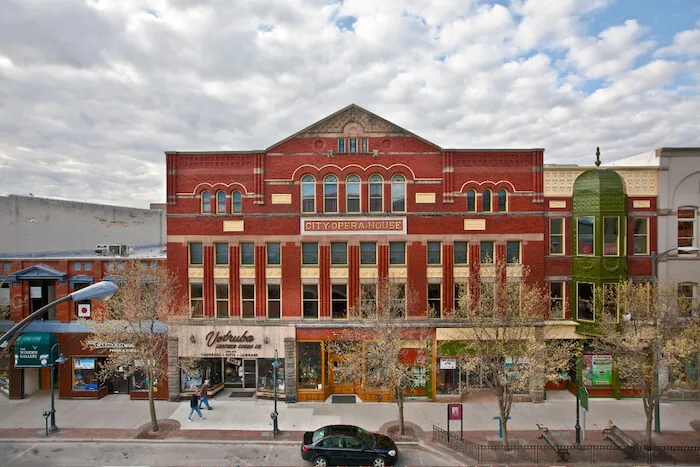
The City Opera House in Traverse City hosted its first actual opera performance in 2011. (Alan Newton via Pure Michigan)
Today they’re hip breweries and luxury living spaces, but once upon a time they were candy factories and hospitals. These are the real origin stories of some of Traverse City’s most storied buildings.
MICHIGAN—Many Michiganders know Traverse City as a prime, summertime vacation hotspot, and home of the National Cherry Festival. But like many northern Michigan towns, the city has its roots in the lumber industry. And those influences are still around today.
Here’s a quick history:
Early Traverse City wasn’t much more than a lone sawmill on Grand Traverse Bay—owned by Perry Hannah and Albert Tracy Lay. Both are regarded as early founders of the city, though Hannah is the only one who became known as the “founding father of Traverse City.”
Even after the lumber supply dried up, it was Hannah who made sure the company helped build up the infrastructure of Traverse City—especially at the turn of the 20th Century. And indeed, several buildings from that historic time period are still standing across the region.
Here’s an overview of some of the oldest surviving buildings:
Sleder’s Family Tavern
- Address: 717 Randolph St.
- Built: 1882

In the late 19th century, Traverse City wasn’t exactly the resort town that it is today.
The west side neighborhood—which was built up by immigrants called Bohemians from the present-day Czech Republic—affectionately called their industrial neighborhood “Slabtown,” because most homes there were built with slabs of scrap wood from nearby sawmills.
Although the area features some nicer living conditions today, Sleders’ is still keeping the working-class spirit of Slabtown alive. Vencel Sleder built this tavern with one reason in mind—to create a place where people could relax after putting in an honest day’s work.
Though almost 150 years old, Sleder’s has the same, 21-foot brass rail mahogany bar. Other hallmarks of the building harken back to its past too, including the 12-foot intricately stamped tin ceiling, old wooden booths, and antique lamps. Following the Sleders, the Cassen, Cairn, and Cox families all brought their own touch to preserving the space over the last century.
Among the decor is taxidermy—and among the taxidermy is a curious stuffed moose named Randolph. A fictional article called “McGuire and the Moose” appeared in Traverse Magazine in 1982, in which a man spins a tall tale about kissing a moose. One woman read the story, and upon encouragement from her friends, climbed on a chair and kissed the stuffed head.
Word spread, and soon enough, Sleder’s was filled with other visitors who wanted to “smooch the moose.” A tradition was born—and it still carries on at the tavern today.
Even the pandemic was not enough to stop some visitors from kissing Randolph in recent years. Some say it’s a Traverse City rite of passage. Others say it bestows good luck. And since Sleder’s has been in business for more than a century—maybe the lucky charm is real.
Visit Sleder’s website, Facebook, and Instagram pages for more information.
The Lofts at Hannah Lay
- Address: 109 E.Front St.
- Built: 1883

Today, the third floor of the Hannah and Lay Mercantile building has been renovated into luxury loft penthouses. But the “Big Store,” as it’s also known, is not just any historic building.
The Hannah and Lay Mercantile is named after Hannah, Lay and Co.—the lumber firm started by the infamous “Father of Traverse City” and its first mayor, Perry Hannah. In the 19th century, the company served as the largest employer in the Traverse City area.

At the time of its founding, the building took up two city blocks and three stories—making it the largest store north of Grand Rapids. The “Big Store,” as residents called it, carried a variety of clothing, shoes, boots, groceries, dry goods, provisions, hardware, and furniture.
The Big Store closed in 1928 and sat vacant until it was reopened by Montgomery Ward in 1937. A fire destroyed the two easternmost bays in 1940—but multiple subsequent owners over the last century have kept the place repaired and renovated to modern standards.
Visit the Lofts at Hannah Lay website for more information.
The Village at Grand Traverse Commons
- Address: 1200 W. Eleventh St.
- Built: 1885

The 63-acre wooded campus of the Village at Grand Traverse Commons—with its historic Victorian Italianate buildings that have been upcycled into tourist-friendly destinations for food and shopping—is truly a unique Traverse City experience. But where did it come from?
Part of the reason the grounds are so beautiful is tied to the “beauty is therapy” health model espoused by officials at the old Traverse City State Hospital, which had a campus there more than 100 years ago. Because the facility opened decades before modern psychiatric medication, Dr. James Decker Munson had a much more holistic approach to medicine.
He believed his patients’ emotional and mental states could be improved naturally if those patients were in beautiful surroundings with a sense of purpose through “work therapy.”
Each patient room was also designed with a window to the outside, to provide natural light and scenic views of the grounds—even for those who weren’t allowed to leave the building.

Throughout its operation as a hospital, more than 50,000 patients received treatment—and the additional cottages were constructed across the campus to accommodate the growth.
Through the 1920s and 1930s, the hospital moved away from the “beauty is therapy” model by offering more peculiar forms of treatment—which evolved into much more invasive and dangerous treatments like electroshock therapy, insulin shock, and lobotomies.
By the 1950s, the use of psychiatric hospitals was growing unpopular. And in 1989, with public outcry from the community, the Traverse City State Hospital finally shuttered its doors.
Residents debated for years about what to do with the old hospital grounds, eventually deciding to protect the structures in the interest of historic value and allowing public access for outdoor recreation. And in 2002, a development contract turned those plans into reality.
Today, the hospital’s main structure and several other buildings have been fully renovated into a mix of upscale restaurants, retail stores, luxury residential space, and an event venue. Several others are still vacant—with renovations yet to come. Historic tours are available.
Visit the Grand Traverse Commons website and Facebook page for more information.
City Opera House
- Address: 106 E. Front St.
- Built: 1891

Despite the name, there were no actual opera performances at this venue until 2011. Why the false name? No other reason than the cultural value of the phrase “Opera House.”
At the time of the City Opera House’s opening, theaters held negative connotations for immorality. And this certainly was not the kind of rowdy image that early city leaders wanted.
So instead, it served as a meeting space and auditorium for a variety of performances from vaudeville to donkey basketball games—but strangely, no opera for more than a century.
The City Opera House was particularly noteworthy because it was the first building in Traverse City to install electric lights. Though more than 50 opera houses existed in Michigan at one point in history, today the City Opera House is only one of six that remain.
The City Opera House closed in 1920 to prevent undue competition for the “talkie” movie theaters on Front Street. However, the building stayed in the Votruba family, who continued to conduct tours. By 1972, it was added to the National Register of Historic Places, and in 1980, the Votruba family donated the building to the city. The community has since completed substantial restoration work, which took place in three phases over two decades.
Today, the beautiful red brick building retains much of its original amenities, such as balcony seats, box seats, original furnishings and decor, and a large stage curtain. Now a nonprofit in partnership with the Wharton Center at Michigan State University, the venue is still used for a wide array of musical performances, theater, comedy, meetings, dances, and more.
For more information, visit the City Opera House website, Facebook, and Instagram pages.
Mackinaw Brewing Company
- Address: 161 E Front St.
- Built: 1892

Though nowadays it’s the home of one of the top-rated brewpubs in the city, the Beadle Building was not always known for flowing taps. Originally, the building was a leather store.
The Beadle Building—like the Grand Traverse Commons and several other historic buildings—was constructed from Markham Brickyard bricks. It was owned by John T. Beadle, whose name still stands today in raised lettering on the original front facade.
In the century that has passed since its construction, the building has housed many businesses—including Grinnell’s Music, Badgero’s Appliances and Floor Coverings, and Cunningham Drugs—until it was bought up by the Mackinaw Brewing Company in 2002.
For more information, visit the brewpub’s website, Facebook, and Instagram pages.
Reynolds-Jonkhoff Funeral Home and Cremation Services
- Address: 305 Sixth St.
- Built: 1893

The Perry Hannah House, if you couldn’t already tell from the name, was built for the “Father of Traverse City,” Perry Hannah. It was his retirement home—and at the time, the anchor of the new Central Neighborhood. Several other historic homes along Sixth Street also mimicked the Queen Anne and French Chateaux architectural style of the home.
Notably, the four-story mansion was the first house in Traverse City to feature central heating, and only the second house to be wired with electricity. As a lumber baron, Hannah included different wood paneling in every room, almost all of them locally-sourced woods.
The home briefly served as a schoolhouse in 1934. In 1937, it was converted into a funeral home—and though it has since changed owners and names, it’s still operating as one today.
Tours are available. Visit the funeral home’s website and Facebook page for more details.
North Peak Brewing Company
- Address: 400 W. Front St.
- Built: 1904

North Peak Brewing Co. is headquartered in Dexter, but Traverse City was its original home for brewing and serving fine ales—and it began, in all places, inside an old candy factory.
This building shifted names over the years from the Big Daylight Candy Factory to the Amiotte Candy Co.and was once a popular manufacturer of chocolates, marshmallows and other confectioneries. It primarily employed young women before it closed down in 1929.
In 1997, three families bought the old factory with plans to turn it into a brewery where they would create “brews and food of uncommon quality.” Though it has since been carefully renovated, North Peak still owns the original building—and operates quite a classy brewpub.
If you look closely, you can still see the original factory fittings and beams inside.
Visit the brewing company’s website, Facebook and Instagram pages for more information.
Crooked Tree Arts Center
- Address: 322 Sixth St.
- Built: 1904

If you’ve ever admired a historic Michigan library building, there’s a good chance that philanthropist and steel baron Andrew Carnegie had something to do with its creation. Between 1901 and 1918, the Carnegie Corporation of New York provided grant money to construct 61 libraries in Michigan—most of which are still operating in some form today.
The Carnegie Library in Traverse City was built in the up-and-coming Central Neighborhood on land granted to the city by Perry Hannah. On its opening day, 350 visitors came to check out books from the beautiful building. And for almost a century, the Traverse City Library and the Traverse City History Center shared the building to provide residents with unique culture.
In 1999, the Traverse City Library moved to a new location. Fifteen years later, in 2014, the Traverse City History Center also left the building. But all was not lost.
After ArtsCenter Traverse City and the Crooked Tree Arts Center merged, the two groups realized they could work together to take care of the old building. Today, the Crooked Tree Arts Center provides year-round art exhibitions and art classes there for all ages.
Visit the Crooked Tree website, Facebook and Instagram pages for more information.
Wellington Inn
- Address: 230 Wellington St.
- Built: 1905

The Boardman Neighborhood was once known as the most prestigious neighborhood in Traverse City. And today, it still hasn’t lost its charm as one of the oldest blocks in the city.
A simple stroll down Washington Street will earn you glimpses of many Victorian era homes.
But one of them has a bit of an interesting backstory: It’s the Wellington Inn.
Once called the Hull House, the inn was built for William Cary Hull and his family. The Hulls were industrialists and owned the Oval Wood Dish Co., which—as you might have imagined—made disposable wooden dishes. Butchers often used them to store their meat.
The 10,000 square-foot neoclassical mansion with nine bedrooms served Hull, his wife, and their five children for about a decade. Then, in 1916, Michigan’s lumber supply dried up, causing Hull and his company to pack up for the more bountiful forests of New York.
After the Hulls moved out, the house stood vacant for about a decade. It was converted into a four-family unit in 1929. And in 1998, the home became known for a storied tragedy.
Traverse City police received a call about its occupant, John Charles Clark, behaving erratically with a handgun in his front yard. After a brief standoff, Sgt. Dennis Finch was shot and killed—marking the first Traverse City police officer to be killed in the line of duty.
Clark went to prison without possibility of parole, a decision which mended community spirits. But the Hull House was not doomed to infamy as the location of a true crime story.
In 2003, the Hull House became a bed and breakfast. It was initially called Antiquities Wellington Inn, which eventually got shortened to Wellington Inn. The bed and breakfast remains a popular romantic getaway, just a short jaunt away from downtown Traverse City.
For more information, visit the Wellington Inn’s website, Facebook and Instagram pages.

VIDEO: Trump isn’t the only republican facing charges for alleged financial crimes
https://www.tiktok.com/@gandernewsroom/video/7361494909938978090 A whole lot of Michigan Republicans and lobbyists are facing criminal charges for...

VIDEO: It’s expensive to be poor in Michigan
https://www.tiktok.com/@gandernewsroom/video/7361154790300060974 Ever heard of predatory payday loans? Here’s how new laws could help protect...

Here’s everything you need to know about this month’s Mercury retrograde
Does everything in your life feel a little more chaotic than usual? Or do you feel like misunderstandings are cropping up more frequently than they...

The ’Gander wins multiple 2023 Michigan Press Association awards
MICHIGAN—The ’Gander Newsroom has earned multiple awards in the 2023 Michigan Press Association Better Newspaper Contest. The awards were announced...

Michigan Republicans ask Supreme Court to restrict medication abortion access
A lawsuit supported by Republicans could disrupt access to the most common form of abortion—even in Michigan, where reproductive rights are...






